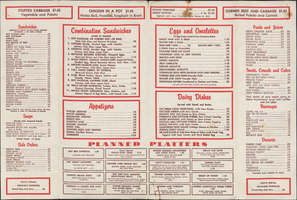Search the Special Collections and Archives Portal
Search Results
Jean Olen Papers
Identifier
Abstract
The Jean Olen Papers (1994-2008) document Olen's career as a taxicab driver in Las Vegas, Nevada. Materials include Olen's personal taxicab driver's permit, medical examiner certificate, and other placards found in taxicabs regarding common questions, such as tipping, no smoking, and airport fees. Also included are newspaper clippings about taxicab drivers in Las Vegas, Nevada and four issues of
Archival Collection
Andre King oral history interview
Identifier
Abstract
Oral history interview with Andre "Brother Dre" King conducted by Claytee D. White on July 20, 2018 for the Remembering 1 October Oral History Project. In this interview, King recalls learning judo and wrestling at an early age. After spending ten years in prison for a burglary offense, he served an additional eleven years in facilities across the state. After twenty-one years in the system, King is now a nondenominational spiritual being and once he learned about the Healing Garden for 1 October victims, he went there daily, during and immediately after the construction. King has helped many survivors and has healed himself as well, through giving love, hugs, and spiritual inspiration.
Archival Collection
Karen Sarret Bartolo oral history interview
Identifier
Abstract
Oral history interview with Karen Sarret Bartolo conducted by Judy Harrell on November 25, 2013 for the West Charleston Neighborhoods--an Oral History Project of Ward 1. Bartolo recalls how it was growing up in Las Vegas, Nevada and her involvement with the Mormon Church. Bartolo then talks about her father's business, her starting a family and teaching for Clark County School District until retiring.
Archival Collection
Faye Rhea Porter oral history interview
Identifier
Abstract
Oral history interview with Faye Rhea Porter conducted by Barbara Tabach on June 13, 2012 for the Boyer Early Las Vegas Oral History Project. In this interview, Porter discusses her father's employment at the Nevada Test Site. Porter talks about her father being unable to describe the type of work he did with family or friends and tells anecdotes about the secrecy of the test site. She then recalls her sister and her employment at the Nevada Test Site until an accident on the way to the site resulted in her death.
Archival Collection
Jennilee Thayer oral history interview
Identifier
Abstract
Oral history interview with Jennilee Thayer conducted by Claytee D. White on August 12, 2009 for the Boyer Early Las Vegas Oral History Project. In this interview, Thayer discusses arriving to Las Vegas, Nevada in 1936 when it was still a mining town. She describes early Henderson, Nevada, attending Basic High School, and recalls her father’s employment at the Basic Magnesium Plant. Lastly, Thayer discusses her employment in show production, atomic bomb testing, and changes in Las Vegas.
Archival Collection
Muriel Parks oral history interview
Identifier
Abstract
Oral history interview with Muriel Parks conducted by Judy Drappo on February 26, 1979 for the Ralph Roske Oral History Project on Early Las Vegas. In this interview, Parks discusses her personal history and the history of the University of Nevada, Las Vegas (UNLV). Parks discusses her career working at UNLV as the Director of Admissions and Records, and how the university has changed over time. Parks also discusses the career of Maude Frazier and their personal relationship.
Archival Collection
Dr. Joseph Rojas oral history interview
Identifier
Abstract
Oral history interview with Dr. Joseph Rojas conducted by Suzanne Lubritz on February 25, 1980 for the Ralph Roske Oral History Project on Early Las Vegas. In this interview, Rojas describes his career as a gynecologist in Las Vegas, Nevada after being stationed at Nellis Air Force Base as chief of OBGYN during his time enlisted in the U.S. Air Force. Rojas also discusses how health care and medicine has evolved in Las Vegas, and Nevada as a whole.
Archival Collection
Thomas McDonald oral history interview
Identifier
Abstract
Oral history interview with Thomas McDonald conducted by Ted Papatheodorou on July 05, 1975 for the Ralph Roske Oral History Project on Early Las Vegas. In this interview, McDonald describes his experiences running a newspaper and a restaurant in Chicago, Illinois before moving to Las Vegas, Nevada to work as a manager at the Stardust Hotel and Casino. McDonald shares several short anecdotes, such as being thrown off of a freight train in 1915 in early Las Vegas, or serving then-Senator Lyndon B. Johnson at his restaurant in Chicago.
Archival Collection
Geneva Stark Merwin oral history interview
Identifier
Abstract
Oral history interview with Geneva Stark Merwin conducted by Elizabeth Nelson Patrick on August 24, 1983 for the Ralph Roske Oral History Project on Early Las Vegas. In this interview, Merwin discusses her career and experiences as a teacher in Pahrump, Nevada after moving there in 1941. Merwin also discusses some of the people in the town and its layout. Merwin goes on to describe her teaching career in Las Vegas, Nevada after being recommended to the school board by Maude Frazier.
Archival Collection

